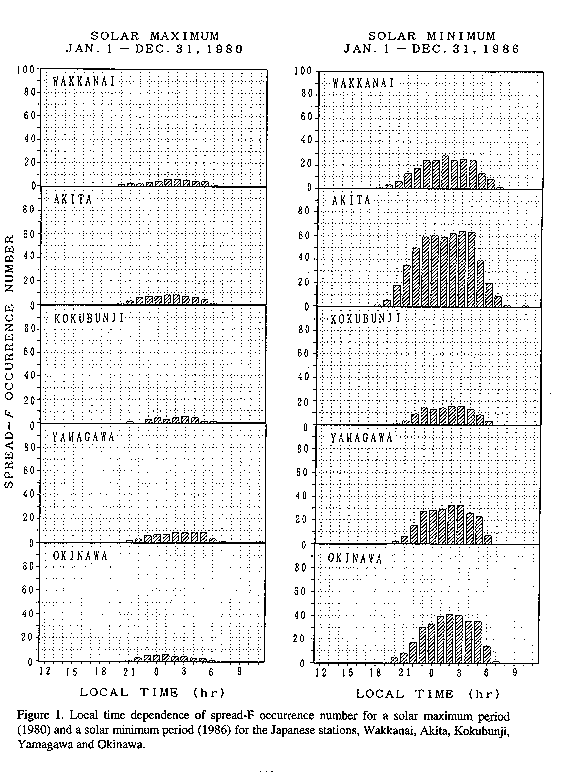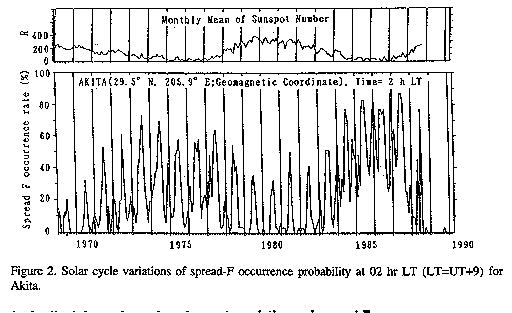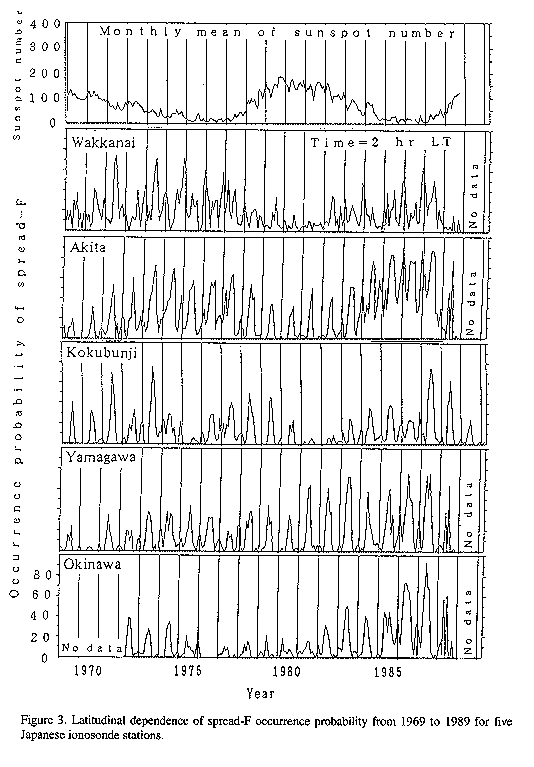Abstract
Statistical results of spread-F occurrence probability are presented by using a long term ionospheric data base for five Japanese ionosonde stations from 1969 to 1989.
It is clearly shown that the spread-F occurrence probability is inversely correlated with sunspot number, especially manifesting at Akita. We found that the difference of spread-F occurrence between summer and winter strongly depends on solar cycles in northern mid-latitude stations for Wakkanai and Akita. Spread-F occurrences at lower latitude stations show different features, when compared with higher mid-latitude stations.
Introduction
A statistical study of spread-F occurrence has been made by many workers. Some recent work on mid-latitude spread-F occurrence is reviewed by Bowman (1990). Statistical results of spread-F occurrence over Japan were shown by Kasuya et. al.(1955) by using the data obtained at four stations for the period from 1949 to 1954. They found that occurrence of spread-F observed over Japan is more prevalent at night in the winter and summer solstices, especially during weak solar activity, and is also more frequent at the northern station. Shimazaki (1959) studied world-wide occurrence probability of spread-F based on the IGY data for the whole world. Thus, in mid-latitudes spread-F occurs more frequently in summer than in winter at stations in the Far East and South America. Bowman (1964) showed spread-F occurrence features by using the data over a 16 year period from 1947 to 1962 for Wakkanai, Akita and Yamagawa. This paper suggests that an inverse relationship between spread-F occurrence and the upper-atmosphere neutral particle density (UA-NPD) levels exists apparently, at least for the Japanese and Australian stations. Seasonal and solar cycle variations of spread-F at the equatorial anomaly crest zone were analyzed by using a long-term data base from 1960 to 1982 (Y.-N. Huang et al., 1987). They noted that frequency spread-F occurrence was much larger than range spread-F, except for equinoxes during high and medium solar activity.
In this report, we used the hourly values in a scaled ionospheric vertical sounding data set obtained at Wakkanai (43.39° N, 141.69° E geographic; 35.3° N, 206.5° E geomagnetic), Akita (49.73° N, 140.13° E geographic; 29.5° N, 205.9° E geomagnetic), Kokubunji (35.71° N, 139.49° E geographic ; 25.5° N, 205.8° E geomagnetic), Yamagawa (31.20° N, 130.62° E geographic; 20.4° N, 198.3° E geomagnetic) for the period from 1968 to 1989 and Okinawa (26.28° N, 127.81° E in geographic; 15.3° N, 196.0° E geomagnetic) for the period from 1972 to 1989.
Diurnal variations of spread-F occurrence

Diurnal variations of spread-F occurrence are shown in figure 1. The total occurrence numbers of spread-F from January to December are compared among five stations. During the solar maximum period in 1980, spread-F appears from 19 hr to 06 hr LT (LT=UT+9), and most frequently postmidnight. The spread-F occurrence number is larger in the solar minimum period than in the solar maximum period. Maximum occurrence period is around 02 hr LT. Of all the stations considered, spread-F occurs less frequently at Kokubunji and occurs more often at Akita. Although not prominant, there seems to be two peaks of spread-F occurrence at about 22-00 hr LT and 02-04 hr LT appearing at Akita and Kokubunji during the solar minimum period. One peak of spread-F occurence at 01-03 hr LT is seen at Wakkanai, Yamagawa and Okinawa during the solar minimum period. During the solar maximum period two peaks of spread-F occurrence are seen only at Kokubunji, and the occurrence peak for Okinawa shifts from around 02 hr LT to around local midnight.
Solar cycle and seasonal variations of spread-F occurrence

Figure 2 shows solar cycle variations of spread-F occurrence probability at 02hr LT in Akita. Spread-F occurrence probability for Akita is anti-correlated with the monthly mean of sunspot number. Remarkable spread-F occurrence peaks appear from June to August and from December to February. During the first solar minimum period, spread-F occurrence in summer is larger than in winter. In 1983, 1985 and 1986 spread-F occurrence in summer is lower than in winter. Using limited ionogram data, Shimazaki (1959) concluded that in mid-latitude, the spread-F occurs more frequently in summer than in winter at stations in the Far East. But our results show that the difference in spread-F occurrence between summer and winter varies with solar activity. These results for solar cycle and seasonal variations of mid-latitude spread-F occurrence might be related in terms of the way UA-NPD changes, which was proposed by Bowman (1964, 1992).
Latitudinal dependence in solar cycle variations of spread-F occurrence

In Figure 3 the spread-F occurrence rates at the five Japanese ionosonde stations are compared. As the occurrence of range type spread-F is rare in Japanese ionosonde data, except for Yamagawa and Okinawa, range and frequency spread-F types are not separated in this analysis. The spread-F occurrence rates for both Wakkanai and Akita show similar occurrence patterns. During a period of sunspot minimum around 1986, spread-F occurrence in winter is larger than in summer. But in other periods, spread-F occurrence in summer is larger than in winter. Spread-F occurrence for Kokubunji shows smooth variations during the increasing or decreasing phase of sunspot numbers. The 75 % peak occurrence of spread-F for Yamagawa during sunspot minimum in 1986 is larger than the 30 % peak occurrence during sunspot minimum in 1976. Spread-F occurrence for Okinawa shows distinctly large occurrence of 90% during sunspot minimum period in 1987. During sunspot maximum period around 1980, spread-F occurrence for Okinawa is lower than 20% occurrence probability.
Conclusions
A long term ionosonde data base for five Japanese ionosonde stations from 1969 to 1989 was used to study solar cycle variations and the latitudinal dependence of mid-latitude spread-F occurrence probability. Several features of solar cycle variations, local time dependence, and latitudinal dependence of the spread-F occurrence probability are summarised as follows;
(1) Spread-F occurrences are inversely correlated with sunspot number, especially at Akita.
(2) Remarkable occurrence peaks appear from June to July in summer and from December to January in winter.
(3) The difference of spread-F occurrence between summer and winter also depends on solar cycles at specific latitude(Akita and Wakkanai). This is different from the results of Shimazaki(1965) who found that in mid-latitudes spread-F occurs more frequently in summer than in winter at stations in the Far East.
(4) Maximum occurrence of spread-F appears in postmidnight from 00 hr LT to 05 hr LT.
(5) Spread-F occurrence probability depends strongly on the latitude of the station. Spread-F occurrence rates at lower latitude stations show different features, when compared with higher latitude stations.
Acknowledgments
The scaled ionogram data used in this study were provided by WDC-C2 for Ionosphere, Communications Research Laboratories, 4-2-1 Nukui-kitamachi, Koganei-shi, 184 Tokyo, Japan.
References
Bowman G. G., Spread-F in the ionosphere and the neutral particle density of the upper atmosphere, Nature, Vol 201, No. 4919, 564-566, 1964
Bowman G.G., A review of some recent work on mid-latitude spread-F occurrence as detected by ionosondes, J.Geomag.Geoelectr., 42, 109-138, 1990.
Bowman G. G., Upper atmosphere neutral-particle density variations compared with spead-F occurrence rates at locations around the world. Ann. Geophysicae, 10, 676-682, 1992.
Huang Yinn-Nien, Kang Cheng and Wen-Ter Huang, Seasonal and solar cycle variations of spread F at the equatorial anomaly crest zone, J. Geomag. Geoelectr., 39, 639-657, 1987.
Kausya Isao, Katano Seizo and Shoji Taguchi,On the occurrence of spread echoes in the F region over Japan, J. Radio Res. Labs., 2, 329-339, 1955.
Shimazaki T., A statistical study of world-wide occurrence probability of spread-F, J.Radio Res.Labs., 6, 669-687, 1965.